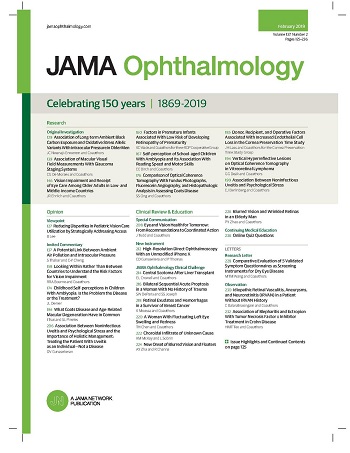糖尿病内皮角膜移植术中DMEK成功后1年内皮细胞损失:一项随机临床试验。
IF 9.2
1区 医学
Q1 OPHTHALMOLOGY
引用次数: 0
摘要
角膜供体糖尿病对Descemet膜内皮角膜移植术(DMEK)后内皮细胞密度(ECD)和形态学的影响尚不清楚。目的探讨DMEK成功后1年角膜内皮细胞损失(ECL)和形态学改变是否与角膜供者糖尿病状况有关。设计、环境和参与者这是一项多中心、双盲、随机临床试验,于2022年2月至2024年7月在美国28个临床点(46名外科医生)和13个眼库进行。该试验包括接受DMEK成功的受者的眼睛(其中一些接受了来自无糖尿病供者的组织,另一些接受了来自糖尿病供者的组织),主要用于治疗Fuchs内皮性角膜营养不良,并且至少有1张可分析的术后内皮图像。干预mek采用无糖尿病或患有糖尿病的供体角膜进行,使用最小化程序进行分配,以达到近似2:1的分布。主要结果和测量:眼库和术后中心内皮细胞镜成像1年后的ecd、ECL、细胞面积变异系数(CV)和六边形细胞百分比(HEX)。结果共纳入1274只眼982例(平均年龄70岁,女性569例(57.9%),非糖尿病供体816例(64.1%),糖尿病供体458例(35.9%))。术前,非糖尿病和糖尿病供体组织的平均(SD)中心ECD分别为2676(290)个细胞/mm2和2671(286)个细胞/mm2。1年时,非糖尿病和糖尿病供体组ECL的平均(SD)分别为28.3%(16.1%)和28.0%(17.0%)(校正后的平均差值= -0.4%;95% CI, -2.3%至1.4%),平均(SD) 1年ECD分别为1927(498)个细胞/mm2和1920(496)个细胞/mm2(校正后的平均差值= 10个细胞/mm2; 95% CI, -36至56;P = 0.95)。与糖尿病严重程度相关的1年ECD无差异(P = 0.97)。两组眼的1年平均(SD) CV无差异(31.5% [4.1%]vs 31.4%[4.1%];调整后平均差= -0.4%;95% CI, -0.9% ~ 0.1%; P =。51),平均(SD) HEX在两组眼睛之间1年无差异(57.7% [5.8%]vs 57.2%[5.8%];调整后平均差异= 0.1%,95% CI, -0.8%至0.9%;P = 0.33)。结论和相关性这项随机临床试验发现,DMEK后1年的ECL和形态学不受角膜供体糖尿病状态的影响。在这项试验中,有糖尿病和无糖尿病的供体组织移植1年的成功率相当,这些发现支持使用糖尿病供体角膜进行内皮角膜移植术。临床试验注册号:NCT05134480。本文章由计算机程序翻译,如有差异,请以英文原文为准。
Endothelial Cell Loss 1 Year After Successful DMEK in the Diabetes Endothelial Keratoplasty Study: A Randomized Clinical Trial.
Importance
The effect of cornea donor diabetes on endothelial cell density (ECD) and morphometry after Descemet membrane endothelial keratoplasty (DMEK) is not known.
Objective
To determine whether endothelial cell loss (ECL) and morphometric changes 1 year after successful DMEK are related to cornea donor's diabetes status.
Design, Setting, and Participants
This was a multicenter, double-masked, randomized clinical trial conducted from February 2022 to July 2024 at 28 US clinical sites (46 surgeons) and 13 eye banks. Included in the trial were the eyes of recipients (some of whom received tissue from donors without diabetes and others who received tissue from donors with diabetes) who underwent successful DMEK, primarily for Fuchs endothelial corneal dystrophy, and had at least 1 analyzable postoperative endothelial image.
Intervention
DMEK performed with a cornea from a donor without or with diabetes, assigned using a minimization procedure to achieve an approximate 2:1 distribution.
Main Outcomes and Measures
ECD, ECL, coefficient of variation in cell area (CV), and percentage of hexagonal cells (HEX) at 1 year from eye bank and postoperative specular central endothelial images.
Results
A total 1274 eyes of 982 recipients (mean [SD] age, 70 [8] years; 569 female [57.9%]; 816 [64.1%] with tissue from donors without diabetes and 458 [35.9%] with tissue from donors with diabetes) were included in the study. Preoperatively, mean (SD) central ECD in tissue from donors without diabetes and with diabetes were 2676 (290) cells/mm2 and 2671 (286) cells/mm2, respectively. At 1 year, mean (SD) ECL was 28.3% (16.1%) and 28.0% (17.0%), in the donor groups without and with diabetes, respectively (adjusted mean difference = -0.4%; 95% CI, -2.3% to 1.4%), resulting in a mean (SD) 1-year ECD of 1927 (498) cells/mm2 and 1920 (496) cells/mm2, respectively (adjusted mean difference = 10 cells/mm2; 95% CI, -36 to 56; P = .95). No difference in ECD at 1 year associated with diabetes severity was noted (P = .97). Mean (SD) CV did not differ at 1 year between the 2 groups of eyes (31.5% [4.1%] vs 31.4% [4.1%]; adjusted mean difference = -0.4%; 95% CI, -0.9% to 0.1%; P = .51), and mean (SD) HEX did not differ at 1 year between the 2 groups of eyes (57.7% [5.8%] vs 57.2% [5.8%]; adjusted mean difference = 0.1%, 95% CI, -0.8% to 0.9%; P = .33).
Conclusions and Relevance
This randomized clinical trial found that ECL and morphometry 1 year after DMEK were not affected by cornea donor diabetes status. With comparable 1-year graft success with tissue from donors with and without diabetes demonstrated in this trial, these findings support the use of corneas from donors with diabetes for endothelial keratoplasty procedures.
Trial Registration
ClinicalTrials.gov Identifier: NCT05134480.
求助全文
通过发布文献求助,成功后即可免费获取论文全文。
去求助
来源期刊

JAMA ophthalmology
OPHTHALMOLOGY-
CiteScore
13.20
自引率
3.70%
发文量
340
期刊介绍:
JAMA Ophthalmology, with a rich history of continuous publication since 1869, stands as a distinguished international, peer-reviewed journal dedicated to ophthalmology and visual science. In 2019, the journal proudly commemorated 150 years of uninterrupted service to the field. As a member of the esteemed JAMA Network, a consortium renowned for its peer-reviewed general medical and specialty publications, JAMA Ophthalmology upholds the highest standards of excellence in disseminating cutting-edge research and insights. Join us in celebrating our legacy and advancing the frontiers of ophthalmology and visual science.
 求助内容:
求助内容: 应助结果提醒方式:
应助结果提醒方式:


